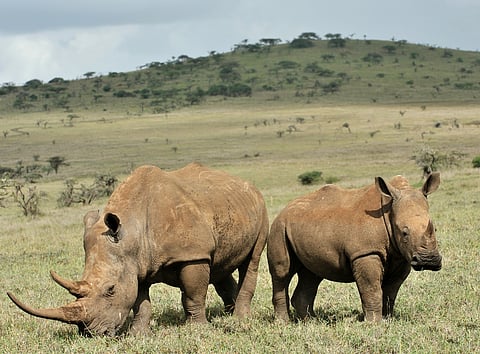The near-extinction of rhinos is at risk of being normalised
The latest State Of The Rhino report reveals a concerning trend: while rhino populations have stabilised at 27,000.
This number is dangerously low compared to historical figures.
Conservationists warn of the 'shifting baseline syndrome,' where acceptance of these numbers as normal could lead to complacency.
Efforts to combat poaching and trafficking continue, but the long-term solution lies in reducing demand for rhino horn, especially in Asia.
A century ago, half a million rhinos roamed Africa and Asia. Today, just 27,000 remain.
The latest annual State Of The Rhino report, released this week by the International Rhino Foundation, shows no dramatic declines in population numbers in the past year. On the surface, this might seem like good news: after decades of poaching, habitat loss and trafficking, rhino numbers are holding steady.
But that stability masks something darker. We may be falling victim to what conservation scientists call “shifting baseline syndrome”, where our expectations deteriorate over time as conditions get worse. Accepting 27,000 as a new normal — something to be celebrated, even – could spell disaster for the long-term future of the rhino.
The report tracks population estimates, threats and conservation progress for all five rhino species:
In Africa, black rhinos numbers have risen slightly to 6,788 (from 6,195), a welcome recovery from the 1990s when they plummeted to just 2,300. But as recently as 1960 there were more than 100,000. White rhinos, the most numerous species, fell to 15,752 (from 17,464). This continues a long-term decline, despite continued efforts to reduce poaching.
In Asia, greater one-horned rhino edged up to 4,075 (from 4,014), but the number of Sumataran rhinos remains perilously low at between 34 and 47, while Javan rhinos have crashed to 50 down from 76 due to illegal hunting.
The report also highlights concerns that rhinos in South Africa — home to most of the world’s rhinos — face long-term genetic risks from inbreeding and will struggle to adapt to change. South Africa’s rhino now survive only in fenced reserves, unable to roam naturally, and therefore live mostly in isolated small populations.
Radioactive rhino horn
The lack of encouraging increases in rhino populations is concerning, as governments and conservationists have made serious efforts to tackle poaching. In South Africa in particular, rhino have been translocated (sometimes by helicopter) to somewhere safer, they’ve had their horns removed, or laced with poison, and/or microchipped, or fitted with GPS trackers. Some are even under guard from dedicated military-grade anti-poaching teams.
Arguably, these actions have had some effect in stemming the loss of African rhino to poachers. But rhino horn is worth so much on the illegal market (between about $11,000 and $22,000, or £8,000 to £16,000, per kilogram) that the illegal killing continues.
So, what next? The latest application of tech is injecting harmless radioactive isotopes into rhino horn to help customs officials detect trafficked horns at borders. This won’t stop poachers killing rhino. But it should make life more difficult for illegal trafficking syndicates.
The case of John Hume
The report is published amid a fresh scandal in South Africa, the epicentre of both rhino conservation and rhino crime.
John Hume, a South African businessman, was the world’s largest private rhino owner with 2,000 animals. He was controversial, as he publicly advocated for an end to the national and international bans on the sale of rhino horn.
Financial difficulties led to Hume selling his herd to NGO African Parks in 2023. Now, he and other alleged syndicate members face charges of fraud and theft over the illegal trafficking of nearly 1,000 rhino horns. Cases like this highlight the scale of the alleged organised crime networks driving the trade — and why it is so hard to police across borders.
What next for rhino?
To save the rhino, we’ll need to disrupt all parts of the illegal rhino horn chain, prevent and catch poachers and traffickers, and put the kingpins behind transnational syndicates out of commission. However, the most impactful long-term action remains comparatively under-resourced: reducing demand.
Large-scale, long-term, well-backed “demand reduction” campaigns to deter ownership and use of rhino horn are needed, especially in Asia where demand is highest. It may take years to shift attitudes. But demand reduction is much safer. Rangers, anti-poaching team members and poachers themselves have all been killed in the protection and pursuit of rhino in the African savanna.
Most importantly, we must not give up. Recovery is possible. For instance, white rhinos bounced back from under 200 animals to over 20,000 before a poaching resurgence this century. With enough resources and effort, rhinos could thrive again.
For the sake of the rhino, their ecosystems and us, we need to reverse habitat loss, bring rhino together into larger healthier populations, and undermine poaching and trafficking of rhino horn. Ultimately, the goal is to bring rhino back from the brink of extinction and toward historical baseline population sizes.
If we accept today’s numbers as “normal”, we risk condemning rhinos to at best permanent near-extinction, with populations only ever a bad government or anarchic war, or a poaching spike or natural disaster, away from being wiped out. And if we can’t save such a huge, charismatic and ecologically important animal, what hope for other species?
Jason Gilchrist, Lecturer in the School of Applied Sciences, Edinburgh Napier University
This article is republished from The Conversation under a Creative Commons license. Read the original article.

